My Mother’s Peasant Bread: The Best Easiest Bread You Will Ever Make
This post may contain affiliate links. Please read my disclosure policy.
This is the no-knead bread recipe my mother has been baking for 45 years. Start to finish, it can be ready in three hours. It bakes in well-buttered Pyrex bowls — no need to preheat a baking vessel for this recipe — and it emerges golden and crisp with a soft, tender crumb. 🍞🍞🍞🍞🍞
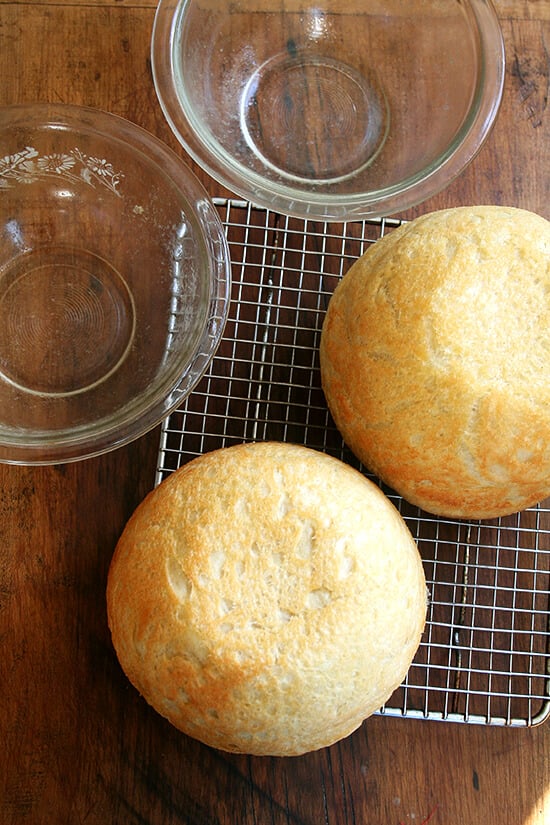
When I tell you that, if forced, I had to pick one and only one recipe to share with you that this — my mother’s peasant bread — would be it, I am serious. I would almost in fact be OK ending the blog after this very post, retiring altogether from the wonderful world of food blogging, resting assured that you all had this knowledge at hand. This bread might just change your life.
The reason I say this is simple. I whole-heartedly believe that if you know how to make bread you can throw one hell of a dinner party. And the reason for this is because people go insane over homemade bread. Not once have I served this bread to company without being asked, “Did you really make this?” And questioned: “You mean with a bread machine?” But always praised: “Is there anything more special than homemade bread?”
And upon tasting homemade bread, people act as if you’re some sort of culinary magician. I would even go so far as to say that with homemade bread on the table along with a few nice cheeses and a really good salad, the main course almost becomes superfluous. If you nail it, fantastic. If you don’t, you have more than enough treats to keep people happy all night long.
The Magic of the Peasant Bread
So what, you probably are wondering, makes this bread so special when there are so many wonderful bread recipes out there? Again, the answer is simple. For one, it’s a no-knead bread. I know, I know. There are two wildly popular no-knead bread recipes out there.
But unlike the others, this is a no-knead bread that can be started at 4:00pm and turned out onto the dinner table at 7:00pm. It bakes in well-buttered Pyrex bowls — there is no pre-heating of the baking vessels in this recipe — and it emerges golden and crisp without any steam pans or water spritzes. This is not artisan bread, nor is it trying to be. It is peasant bread, spongy and moist with a most-delectable buttery crust.
Genuinely, I would be proud to serve this bread at a dinner party attended by Jim Lahey, Mark Bittman, Peter Reinhart, Chad Robertson, Jeff Hertzberg and Zoe Francois. It is a bread I hope you will all give a go, too, and then proudly serve at your next dinner party to guests who might ask where you’ve stashed away your bread machine. And when this happens, I hope you will all just smile and say, “Don’t be silly. This is just a simple peasant bread. Easy as pie. I’ll show you how to make it some day.”
Peasant Bread Variations
Once you master the peasant bread, you can make any bread your heart desires — this simple no-knead bread recipe is the foundation of many of the other bread recipes on this site, namely this hugely popular overnight refrigerator focaccia and this simple homemade pizza dough. It’s even the inspiration behind this sourdough focaccia and this sourdough sandwich bread and this simple pita bread recipe.
The below post is organized as follows:
- How to Make Peasant Bread, Step by Step
- The Best Way to Store Bread
- Peasant Bread Dinner Rolls
- Peasant Bread Sandwich Bread
- How to Add Seeds and Nuts to Bread Dough
- How to Make Gluten-Free Peasant Bread
- How to Coat the Loaves in Seeds
- How to use Whole Wheat Flour
- How to Bake the Peasant Bread in a Dutch Oven
Many more variations on the peasant bread can be found in my cookbook, Bread Toast Crumbs:
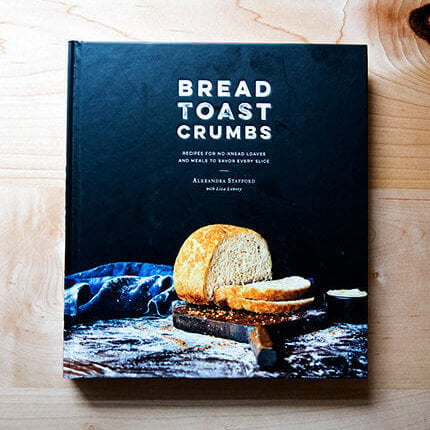
Bread Toast Crumbs
Love the peasant bread? There’s now a book filled with 40 simple bread recipes plus 70 recipes to use up every crumb of every loaf you bake.
How to Make Peasant Bread, Step by Step
First: You need yeast.
This is the yeast I buy exclusively: SAF Instant Yeast. Instant yeast can be whisked into the flour directly without any blooming or proofing. If you want to stick to active-dry yeast, there are instructions in the recipe notes on how to do so. Red Star yeast is great.
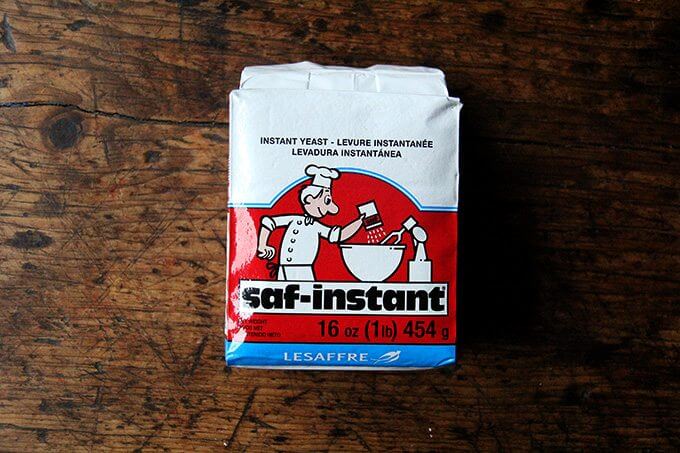
Whisk together flour, salt, sugar, and instant yeast. Add lukewarm water.
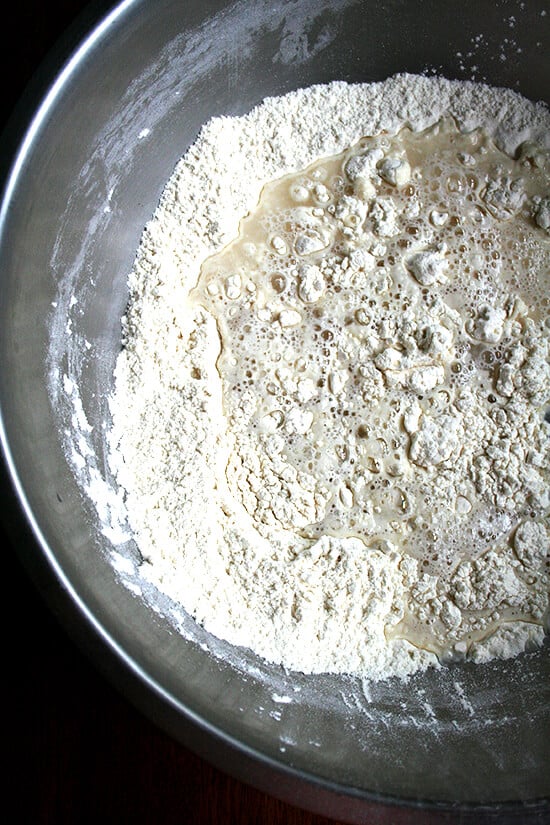
Mix until you have a sticky dough ball. Let it rise for 1.5 to 2 hours…
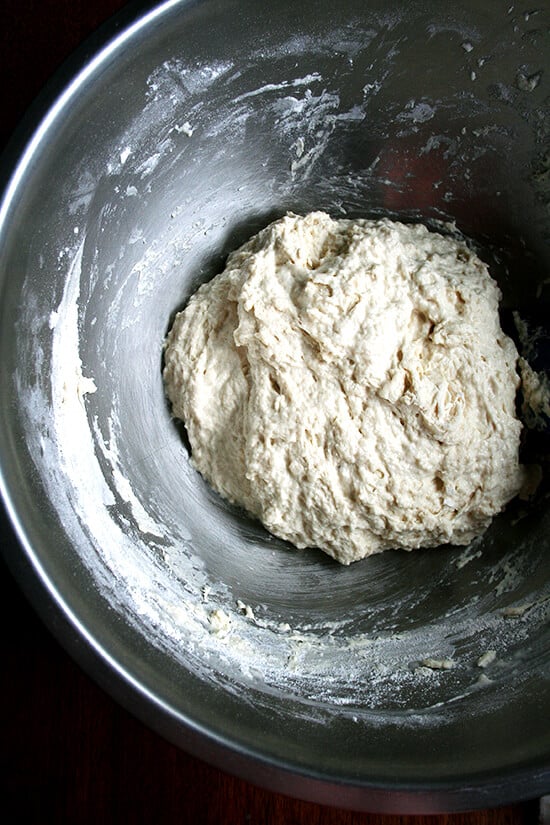
… or until it looks like this:
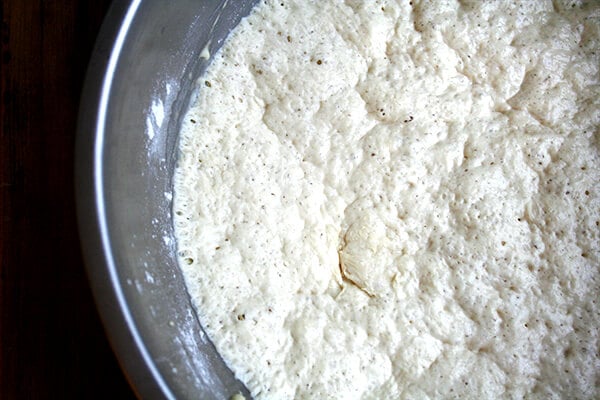
Punch down the dough using two forks.
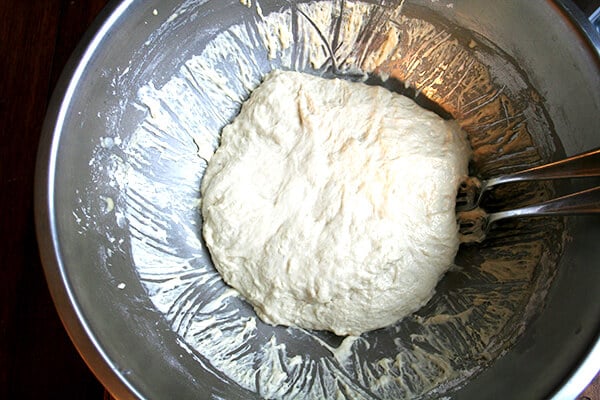
Then split the dough down the middle again using the two forks.
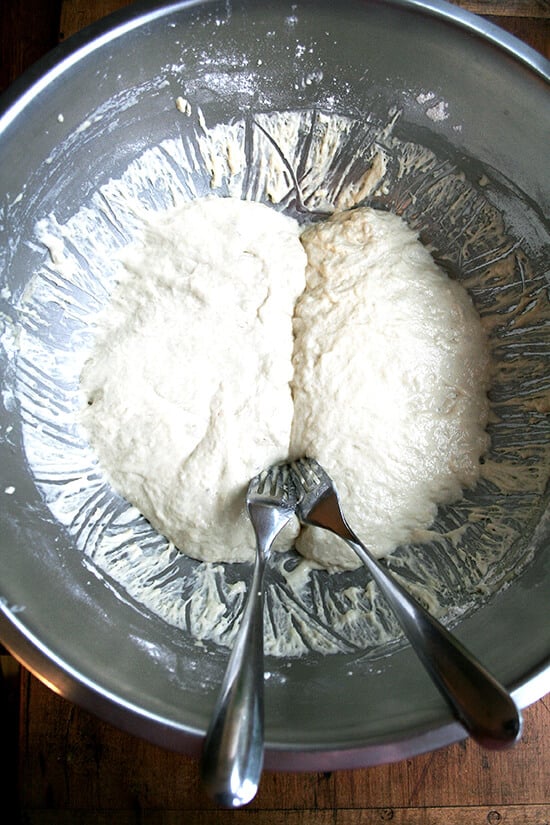
Because this is a very wet dough, it must be baked in an oven-proof bowl. I am partial to the Pyrex 1L 322 size, but any similarly sized oven-proof bowl will work.
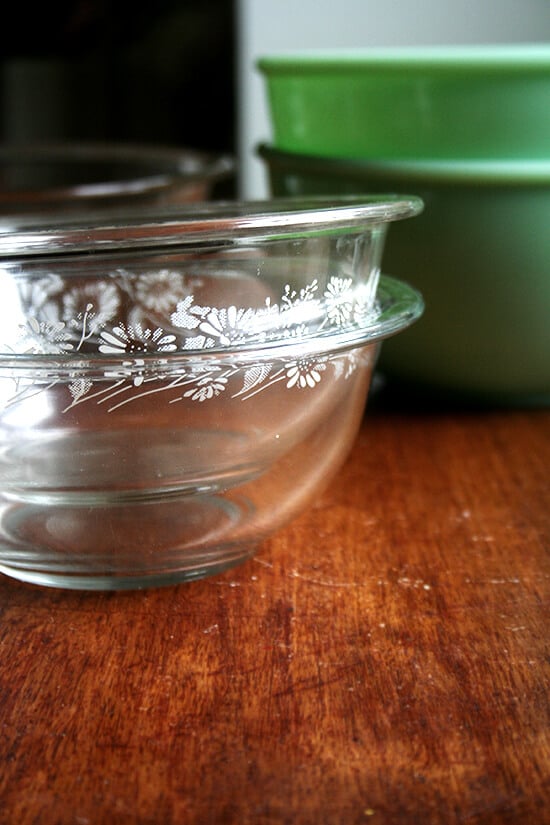
Butter the bowls well; then transfer half of the dough to each prepared bow.
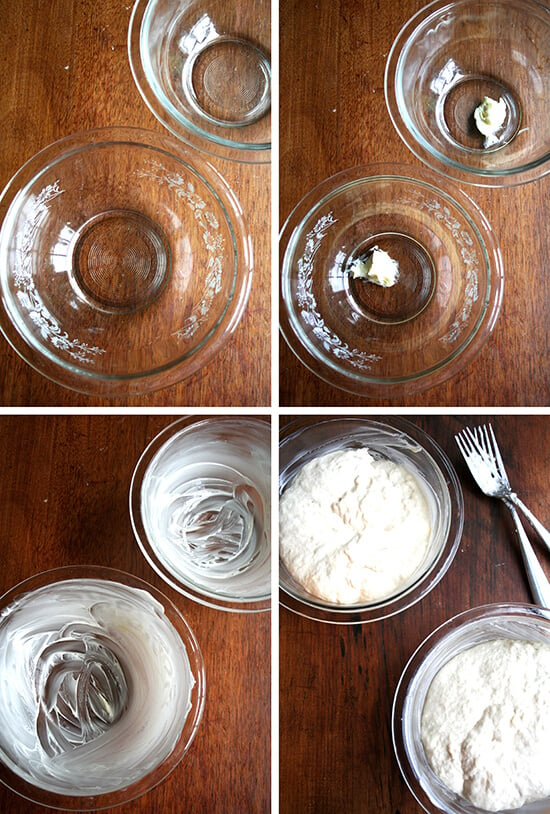
Let the dough rise again until it crowns the rim of the bowl, about 30 minutes.
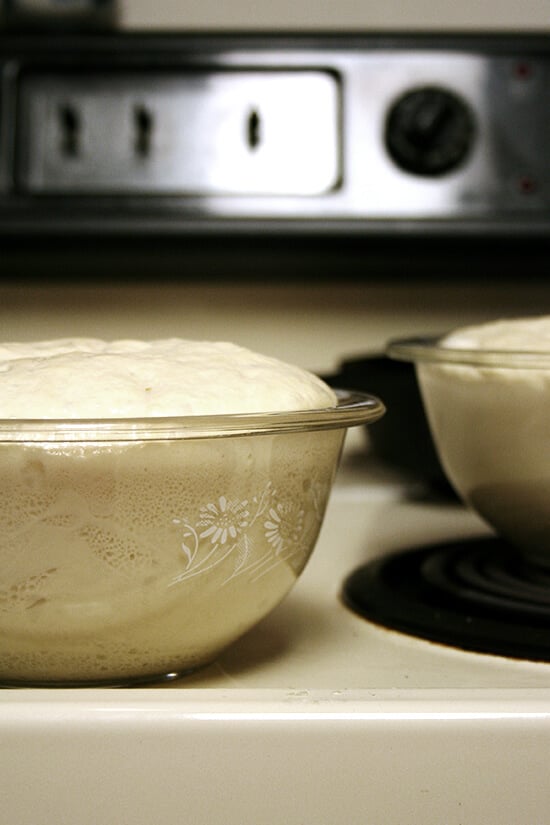
Transfer the bowls to the oven to bake:
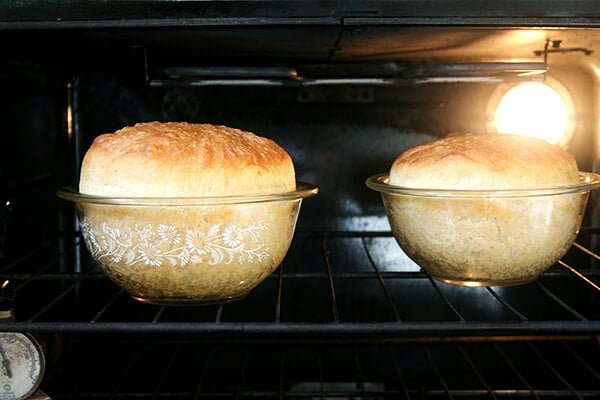
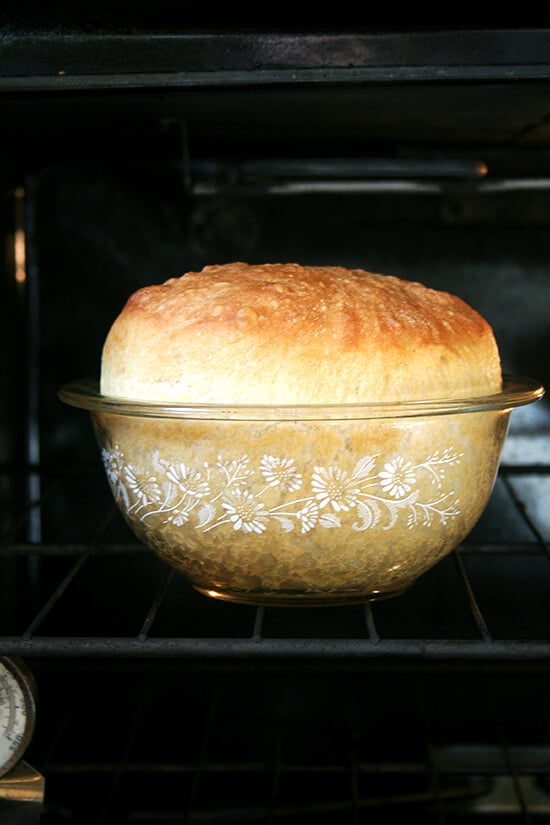
This bread is irresistible when it’s freshly baked, but it also makes wonderful toast on subsequent mornings as well as the best grilled cheese. It’s also my favorite bread to use for these egg salad sandwiches and for this no-tuna “tuna” salad.
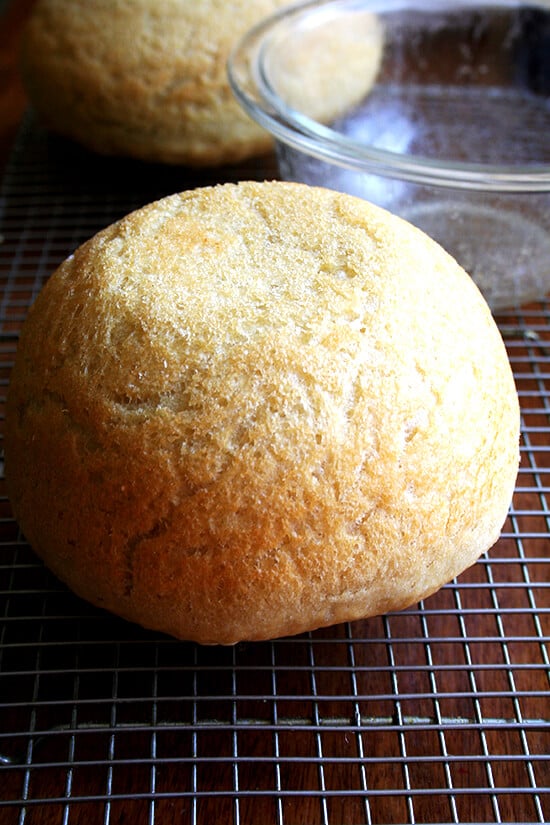
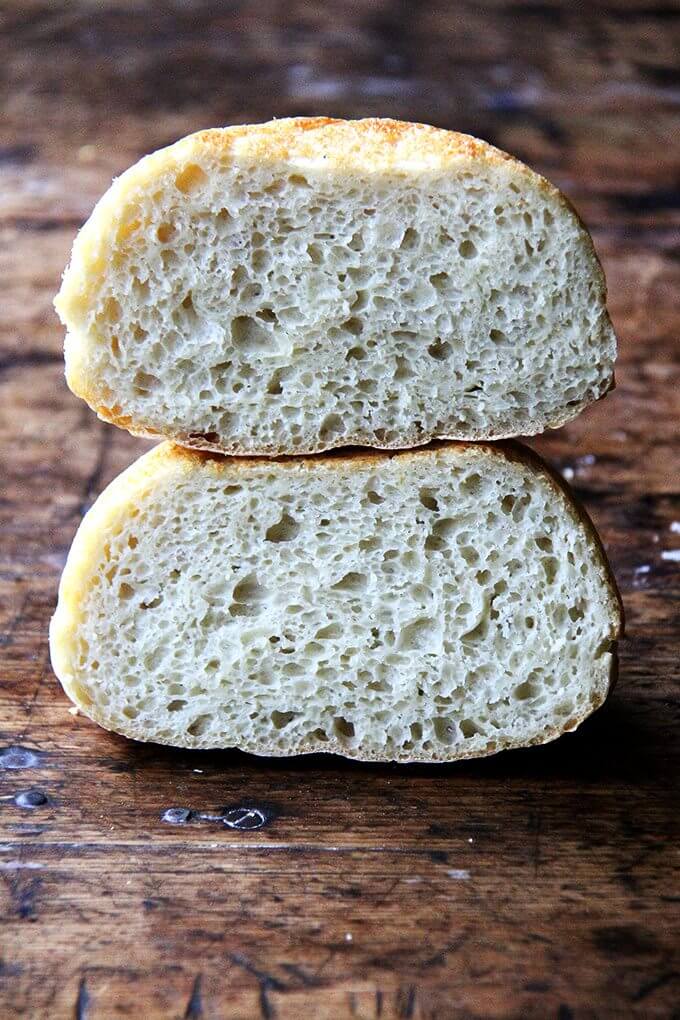
The Best Way to Store Bread
If you want to store the bread at room temperature for 3 to 4 days, I think the best method is in a ziplock bag. I’ve tried other eco-friendly options, but nothing seems to keep bread freshest — the crumb the softest — better than a ziplock bag. You can re-use the bags again and again.
If you intend to keep the bread for longer, I would freeze it. I often slice bread as soon as it cools completely, transfer the slices to a ziplock bag, then freeze. This way, I know the bread was frozen at its freshest.
A ziplock bag will not prevent the crust of bread from turning soft, which is why I suggest always reheating day-old bread. I use a toaster at breakfast for slices of bread, and I reheat half or quarter loaves in the oven at 350ºF for 15 to 20 minutes when serving for dinner.
Bread revives so beautifully in the oven or toaster.
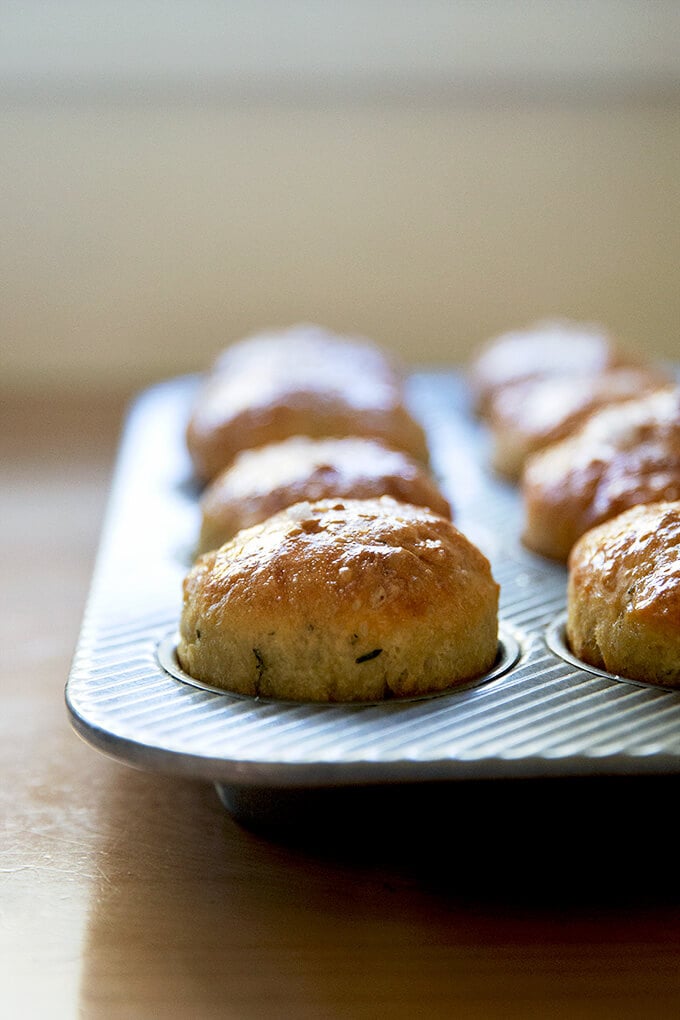
No-Knead Dinner Rolls
To use the peasant bread dough to make rolls, simply divide the dough into smaller portions and place in a buttered muffin tin as in these No-Knead Thyme Dinner Rolls (pictured above). This recipe for no-knead buttermilk pull-apart rolls is also based on the peasant bread as are these brioche pull-apart rolls.
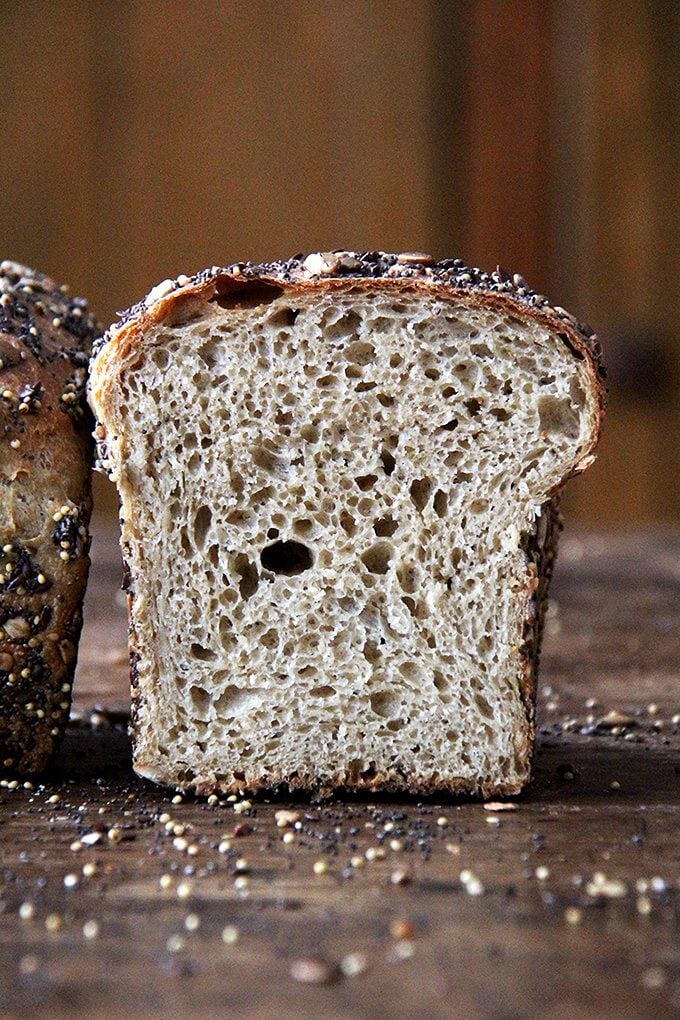
No-Knead Sandwich Bread
To make sandwich bread, multiply the recipe below by 1.5 and bake the bread in two buttered 8.5×4.5-inch loaf pans.
Made with half all-purpose flour and half King Arthur Sprouted Wheat Flour, these seed-coated sandwich loaves (pictured above) have a soft and light crumb. I really like KAF’s sprouted wheat flour, which is made from white whole wheat berries that, when sprouted, yield a creamy, sweet, milder-tasting flour. You can use 100% all-purpose or bread flour for an even lighter loaf or your favorite whole wheat flour in place of the sprouted wheat flour.
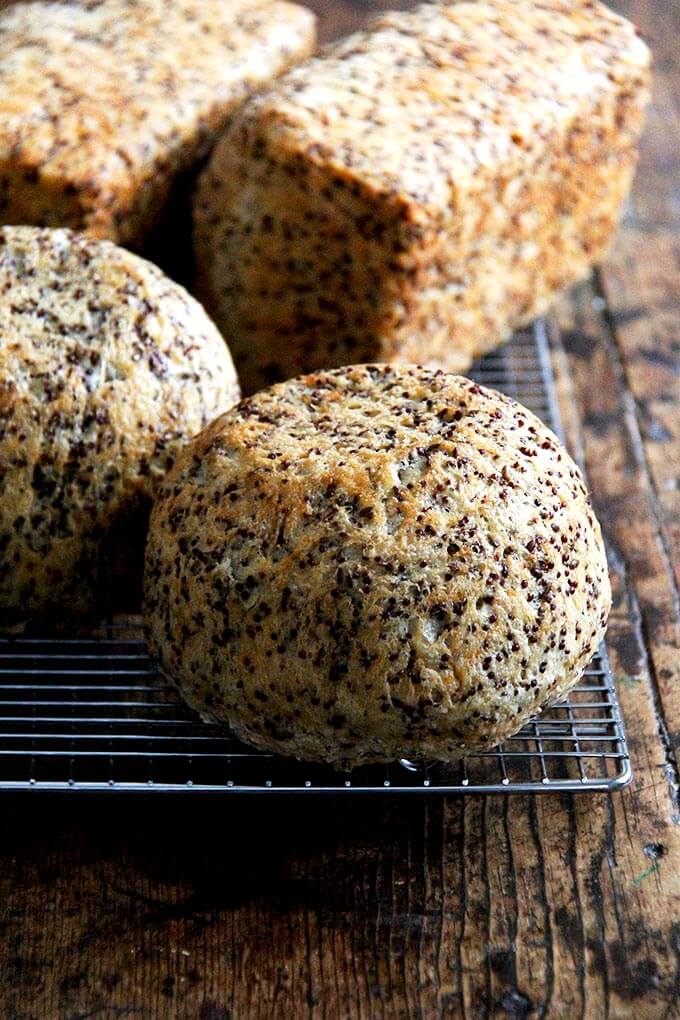
How to Add Nuts and Seeds to Bread Dough
To add seeds and nuts (or dried fruit and cheese), simply stir them into the dry ingredients. This recipe for Quinoa-and-Flax Toasting Bread will offer guidance on how much to add.
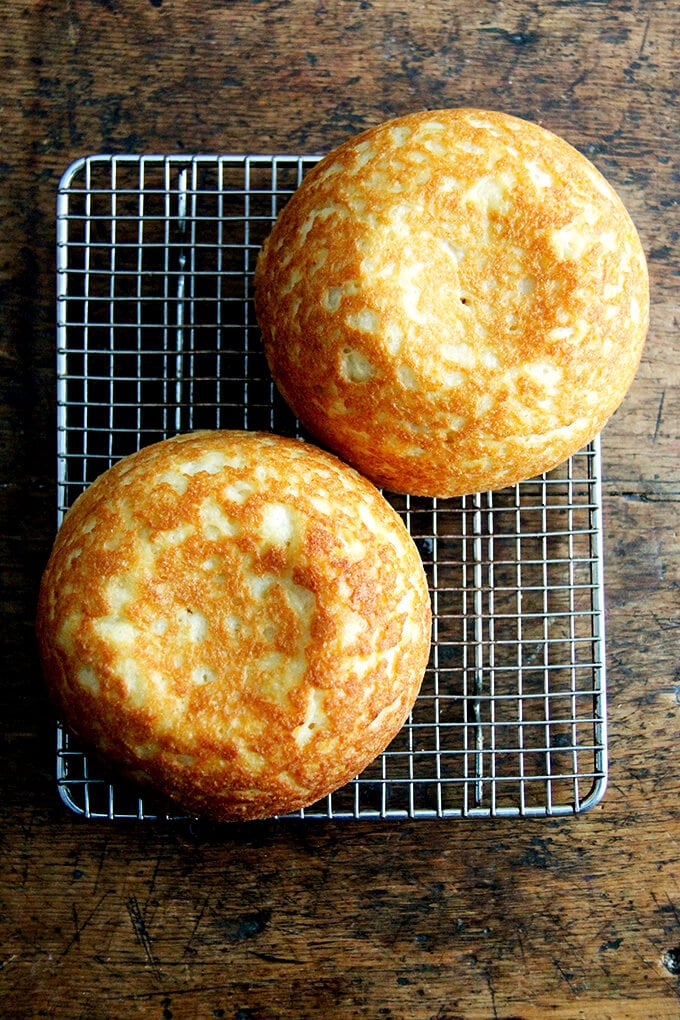
How to Make a Gluten-Free Peasant Bread
Making gluten-free peasant bread (pictured above) unfortunately isn’t as simple as swapping in gluten-free flour for the wheat flour. But the process and recipe is still super simple — in fact, because there’s only one rise, many people find the gluten-free peasant bread to be even simpler than the original. Find the recipe here: Gluten-Free Peasant Bread
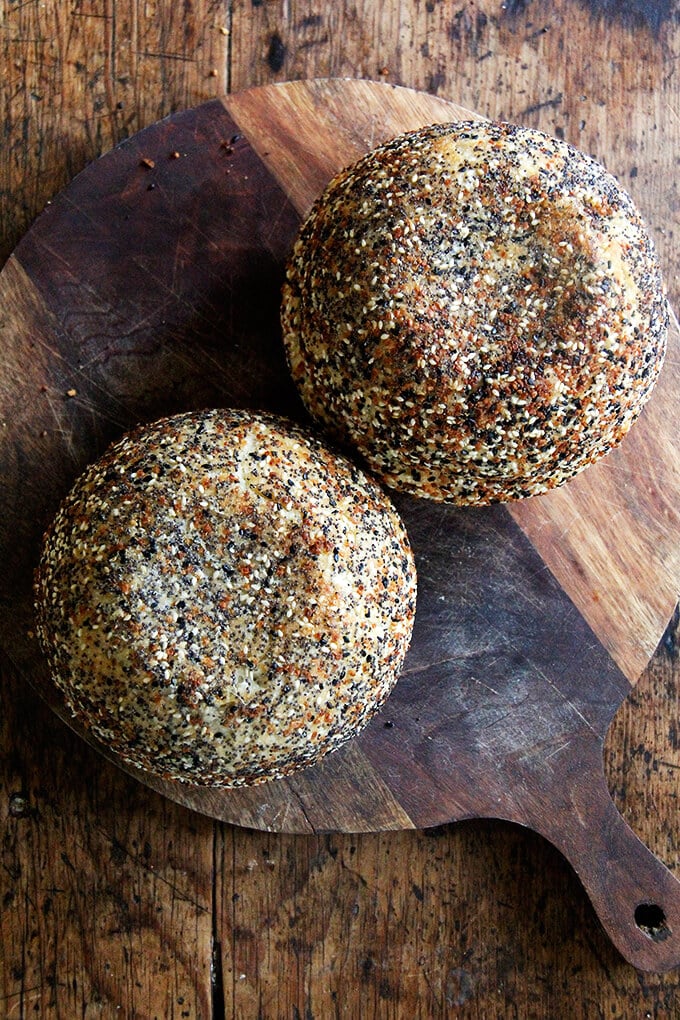
How to Coat the Loaves in Seeds
To coat the peasant bread in seeds, as pictured above, simply coat the bowls with everything bagel seasoning or with dukkah or sesame seeds or whatever seed mix you wish. The seed-coated loaves look so beautiful, and it’s amazing how much the flavor of the coating permeates the loaves. Find the recipe here: Everything Bagel Seasoning Peasant Bread
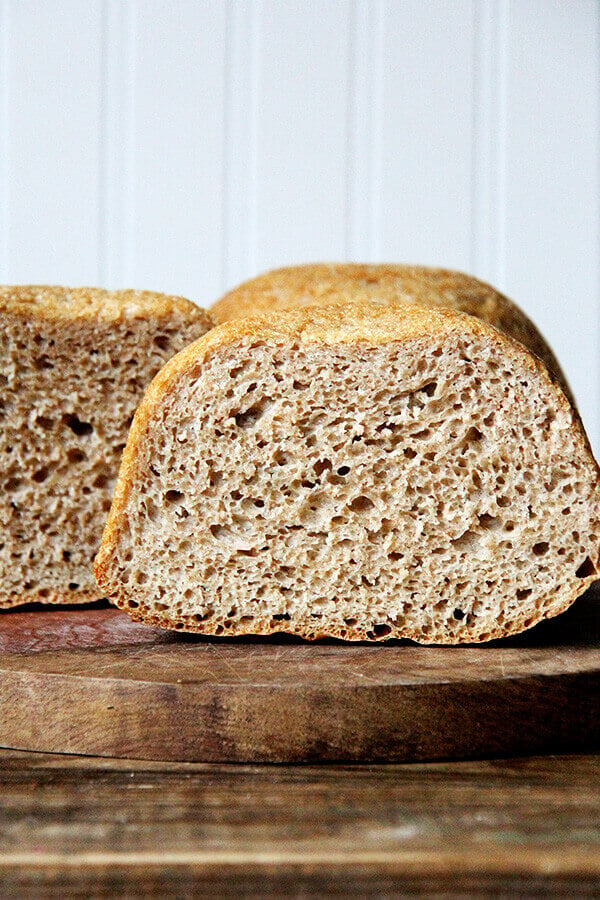
How to Use Whole Wheat Flour
To use whole wheat flour in the peasant bread, simply replace as much as 50% of the all-purpose flour with your favorite whole wheat flour: I like KAF’s sprouted wheat flour, and I’ve been loving the Cairnsprings Mill Trailblazer stone-milled flour. With the Trailblazer, I can use up to 75% of it in the peasant bread, and it yields a beautiful, chewy texture as well as a lovely flavor and aroma.
When using whole wheat flour, you may have to use more or less water — there is no rule as to how much more or less, and it will take some trial and error to get right because all flours absorb water differently. When I use KAF sprouted wheat flour, for example, I don’t change the water amount at all. When I use the Trailblazer flour, on the other hand, I reduce the water by at least 50 grams.
If you’d like to learn more about whole wheat flour and stone-milled flours, read this: Easy Sourdough Bread (Whole Wheat-ish)
How to Bake the Peasant Bread in a Dutch Oven
If you’re looking for more of a crackling crusted boule (characteristic of a loaf of sourdough bread) as opposed to the buttery crispness of the peasant bread, you can bake the peasant bread dough in a preheated Dutch oven.
There are detailed instructions below the recipe in the notes section, but one thing to keep in mind before you begin is dough hydration. The peasant bread is a very high hydration dough, meaning there is a lot of water relative to flour. Because baking the peasant bread in a Dutch oven will require some handling of the dough — to shape it into a round and to create some tension — you may want to reduce the water from the start. Consider holding back 20-30 grams of water to make the process more manageable for you.
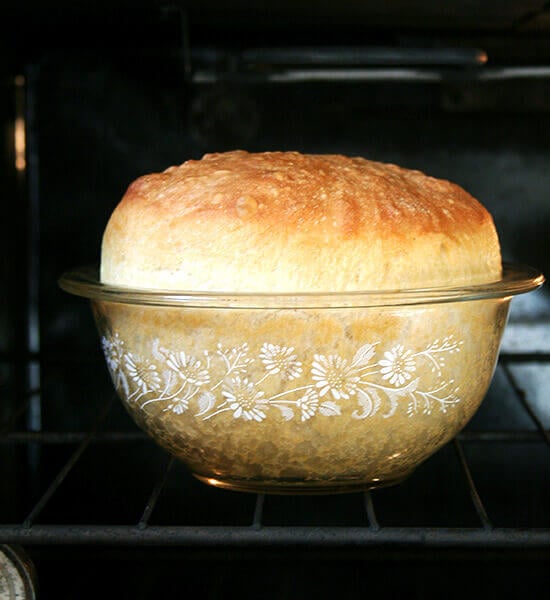
My Mother’s Peasant Bread: The Best Easiest Bread You Will Ever Make
- Total Time: 2 hours 27 minutes
- Yield: 2 loaves
Description
Notes:
The bread:
This is a sticky, no-knead dough, so, some sort of baking vessel, such as pyrex bowls (you need two 1-qt bowls) or ramekins for mini loaves is required to bake this bread. See notes below the recipe for sources. You can use a bowl that is about 2 qt or 2 L in size to bake off the whole batch of dough (versus splitting the dough in half) but do not use this size for baking half of the dough — it is too big.
Peasant Bread Fans! There is now a book: Bread Toast Crumbs, a loaf-to-crumb bread baking book, filled with tips and tricks and answers to the many questions that have been asked over the years. In the book you will find 40 variations of the master peasant bread recipe + 70 recipes for using up the many loaves you will bake. Learn more about the book here or buy it here.
Ingredients
- 4 cups (512 g) unbleached all-purpose or bread flour
- 2 teaspoons (10 g) kosher salt
- 2 cups (454 g) lukewarm water (made by mixing 1.5 cups cold water with 0.5 cup boiling water)
- 2 teaspoons (8 g) sugar
- 2 teaspoons (8 g) instant yeast, I love SAF Instant Yeast, see notes below
- room temperature butter, about 2 tablespoons
Instructions
- Mixing the dough: In a large mixing bowl, whisk together the flour, salt, sugar, and instant yeast (I love SAF Instant Yeast). Add the water. Mix until the flour is absorbed. (If you are using active dry yeast, see notes below.)
- Let it rise. Cover bowl with a tea towel or plastic wrap and set aside in a warm spot to rise for at least an hour. (In the winter or if you are letting the bread rise in a cool place, it might take as long as two hours to rise.) This is how to create a slightly warm spot for your bread to rise in: Turn the oven on at any temperature (350ºF or so) for one minute, then turn it off. Note: Do not allow the oven to get up to 300ºF, for example, and then heat at that setting for 1 minute — this will be too hot. Just let the oven preheat for a total of 1 minute — it likely won’t get above 100ºF. The goal is to just create a slightly warm environment for the bread.
- Preheat the oven to 425ºF. Grease two 1-qt or 1.5-qt oven-safe bowls (see notes below) with about a tablespoon of butter each. Using two forks, punch down your dough, scraping it from the sides of the bowl, which it will be clinging to. As you scrape it down try to pull the dough toward the center (see video below for guidance). You want to loosen the dough entirely from the sides of the bowl, and you want to make sure you’ve punched it down. Then, take your two forks and divide the dough into two equal portions — eye the center of the mass of dough, and starting from the center and working out, pull the dough apart with the two forks. Then scoop up each half and place into your prepared bowls. This part can be a little messy — the dough is very wet and will slip all over the place. Using small forks or forks with short tines makes this easier — my small salad forks work best; my dinner forks make it harder. It’s best to scoop it up fast and plop it in the bowl in one fell swoop. Some people like to use flexible, plastic dough scrapers for this step.
- Let the dough rise again for about 20 to 30 minutes on the countertop near the oven (or near a warm spot) or until it has risen to just below or above (depending on what size bowl you are using) the top of the bowls. (Note: Do not do the warm-oven trick for the second rise, and do not cover your bowls for the second rise. Simply set your bowls on top of your oven, so that they are in a warm spot. Twenty minutes in this spot usually is enough for my loaves.)
- Bake it. Bake for 15 minutes. Reduce the heat to 375º and bake for 15 to 17 minutes longer. Remove from the oven and turn the loaves onto cooling racks. If you’ve greased the bowls well, the loaves should fall right out onto the cooling racks. If the loaves look a little pale and soft when you’ve turned them out onto your cooling racks, place the loaves into the oven (outside of their bowls) and let them bake for about 5 minutes longer. Remove from oven and let cool for 10 minutes before cutting.
Notes
- The bowls: The cheapest, most widely available 1-qt bowl is the Pyrex 322. Update: These bowls are becoming harder to find and more expensive. As a result, I’m suggesting this cheaper option: the Pyrex 3-piece set. You can split the dough in half as always (see recipe) and bake half in the 1-quart bowl and half in the 1.5 quart bowl. The loaves will not be the same shape, but they will be delicious nonetheless.
- Yeast: I buy SAF Instant Yeast in bulk from Amazon I store it in my fridge or freezer, and it lasts forever. If you are using the packets of yeast (the kind that come in the 3-fold packets), just go ahead and use a whole packet — It’s 2.25 teaspoons. I have made the bread with active dry, rapid rise, and instant yeast, and all varieties work. The beauty of instant yeast is that there is no need to “proof” it — you can add the yeast directly to the flour. I never use active-dry yeast anymore.
- If you have active-dry yeast on hand and want to use it, here’s how: In a small mixing bowl, dissolve the sugar into the water. Sprinkle the yeast over top. There is no need to stir it up. Let it stand for about 10 to 15 minutes or until the mixture is foamy and/or bubbling just a bit — this step will ensure that the yeast is active. Meanwhile, in a large bowl, whisk together the flour and salt. When the yeast-water-sugar mixture is foamy, stir it up, and add it to the flour bowl. Mix until the flour is absorbed.
- Troubleshooting: You can find step-by-step video instruction here.
- Several commenters have had trouble with the second rise, and this seems to be caused by the shape of the bowl they are letting the dough rise in the second time around. Two hours for the second rise is too long. If you don’t have a 1-qt bowl, bake 3/4 of the dough in a loaf pan and bake the rest off in muffin tins or a popover pan. The second rise should take no more than 30 minutes.
- Also, you can use as many as 3 cups of whole wheat flour, but the texture changes considerably. I suggest trying with all all-purpose or bread flour to start and once you get the hang of it, start trying various combinations of whole wheat flour and/or other flours.
- The single most important step you can take to make this bread truly foolproof is to invest in a digital scale. This one costs under $10. If you are not measuring by weight, do this: scoop flour into the measuring cup using a separate spoon or measuring cup; level off with a knife. The flour should be below the rim of the measuring cup.
- Here’s a printable version of this recipes that’s less wordy: Peasant Bread Recipe, Simplified
- How to Bake the Peasant Bread in a Dutch Oven: Preheat a Dutch Oven for 45 minutes at 450ºF. Dust a clean work surface with flour. After the first rise, turn the dough out onto the floured surface and shape it into a ball: I like to fold it envelope style from top to bottom, then side to side; then I flip it over and use the pinkie edges of my hands to pinch the dough underneath and create some tension. Transfer the dough to a sheet of parchment paper. Let rest for 20 minutes. If you feel your dough is spreading too much you can lift up the sheet of parchment paper, dough and all, and place it in a bowl of a similar size. After the 20 minutes, transfer the dough, parchment paper and all to the Dutch oven. Carefully cover it. Bake 30 minutes. Uncover. Bake 15 minutes more.
- To bake the peasant bread in a loaf pan: If you are using an 8.5×4.5-inch loaf pan or a 9×5-inch loaf pan, you can bake 3/4 of the dough in it; bake off the rest of the dough in ramekins or other small vessels … the mini loaves are so cute. You can also make 1.5x the recipe, and bake the bread in 2 loaf pans. If you have a large loaf pan, such as a 10×6-inch loaf pan, you can bake off the entire batch of dough in it. For loaf pans, bake at 375ºF for 45 minutes.
- How to Bake at Hight Altitude:
- First try the original recipe as written (preferably with a scale). You may not need to make any adjustments. One commenter, who lives at 9200 ft finds the original recipe to work just fine as is.
- If the original recipe doesn’t work, try adding a little bit more water because it rises fast and it is so dry: about a quarter cup for every 512 g of flour.
- Try decreasing the yeast to 1.5 teaspoons.
- If your dough is especially gooey, try decreasing the water by 1/4 cup. But, if you aren’t using a scale, my first suggestion would be to buy a scale and weigh the flour, and make the bread once as directed with the 2 cups water and 512 grams flour, etc.
- Punch the dough down twice before transferring it to the buttered Pyrex bowls. In other words, let it rise for 1-1.5 hours, punch it down, let it rise again for about an hour, punch it down, then transfer it to the buttered bowls.
- Variations:
- #1. Cornmeal. Substitute 1 cup of the flour with 1 cup of cornmeal. Proceed with the recipe as directed.
- #2. Faux focaccia. Instead of spreading butter in two Pyrex bowls in preparation for baking, butter one 9×9-inch glass baking dish and one Pyrex bowl or just butter one large 9×13-inch Pyrex baking dish. If using two vessels, divide the dough in half and place each half in prepared baking pan. If using only one large baking dish, place all of the dough in the dish. Drizzle dough with 1 tablespoon of olive oil (if using the small square pan) and 2 tablespoons of olive oil (if using the large one). Using your fingers, gently spread the dough out so that it fits the shape of the pan. Use your fingers to create dimples in the surface of the dough. Sprinkle surface with chopped rosemary and sea salt. Let rise for 20 to 30 minutes. Bake for 15 minutes at 425ºF and 17 minutes (or longer) at 375ºF. Remove from pan and let cool on cooling rack.
- #3. Thyme Dinner Rolls
- #4 Gluten-free
- #5. Everything Bagel Seasoning Bread. Simply coat the buttered bowls with Everything Bagel Seasoning. Watch a how-to on Instagram Stories here.
- #6: Whole Wheat Peasant Bread. Use as much as 50% whole wheat flour. I like King Arthur Flour’s white whole wheat flour (see this post) or sprouted wheat flour (see this post).
- Prep Time: 5 minutes
- Cook Time: 32 minutes
- Category: Bread
- Method: Baked
- Cuisine: American
This post may contain affiliate links. Please read my disclosure policy.

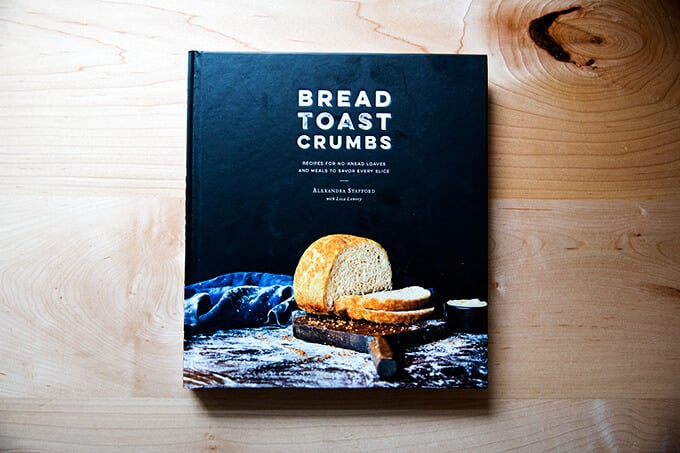
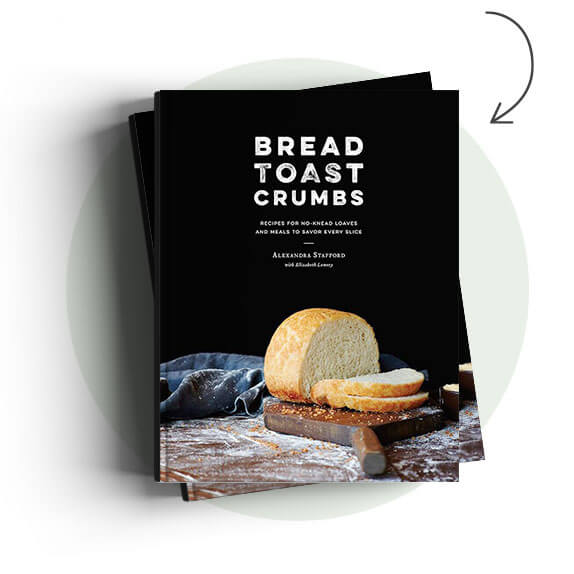

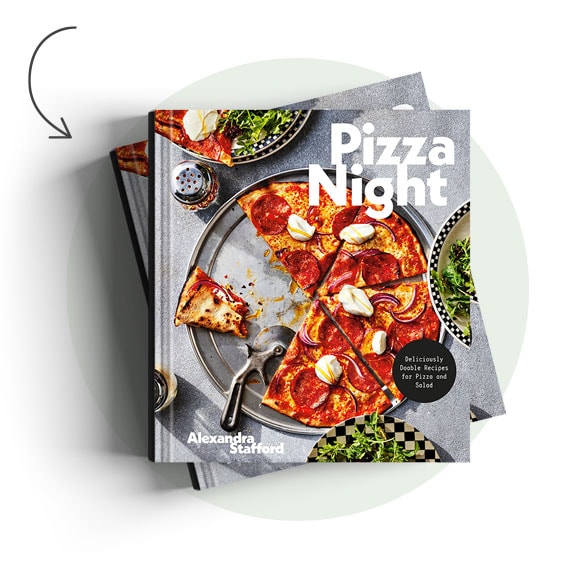

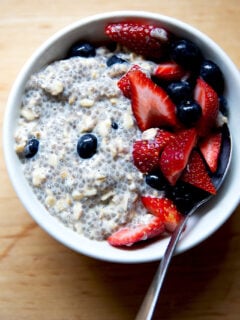
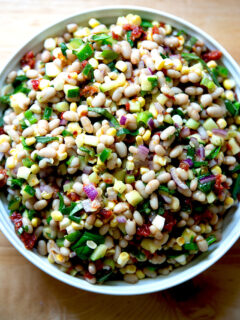
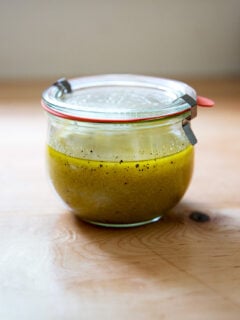
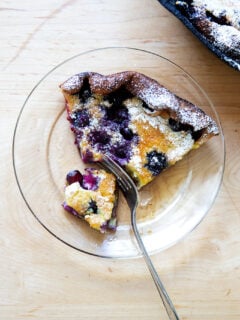


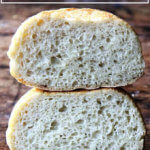
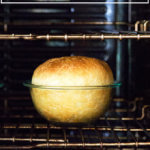
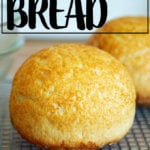
6,387 Comments on “My Mother’s Peasant Bread: The Best Easiest Bread You Will Ever Make”
We cannot wait to try this! I only have a Pyrex bowl #325, which is 2.5 L. Will this work as one large loaf? And if so, would I just need to adjust the baking time?
Thank you!
Yes, it will! Extend the cooking time by 10-15 minutes. Happy Baking! 🍞
Hi there!
Would you recommend substituting sourdough starter for the yeast? If that’s possible could you provide ratios and give rise times? Thank you!!!
Hi Marie! Check out this post: Simple Sourdough Sandwich Loaf. It’s essentially the peasant bread proportions but with sourdough starter. You can use that recipe as a guide but instead of transferring the dough to the loaf pan, split it and transfer to the buttered Pyrex bowls.
Baked this as a sourdough as I couldn’t get any yeast. It was delicious! My family loves it so much that it how I make it now.
Wonderful to hear this, Lisa!
can I bake this recipe in a 2.5 quart bowl and at 375 for 45 min.
I have tried it at two temp per recipe but my oven is a bit difficult to change in mid baking.
It is an excellent recipe
Yes, absolutely!
Can you add things like cinnamon, brown sugar, or chocolate chips?
Sure! Add them into the dry ingredients.
Hi Ali!
Warm Greetings from Singapore!
I thought I posted my questions earlier but they didn’t show up so let me try again.
I really want to bake this recipe but I don’t have the 1L Pyrex glass bowls. What I do have are two 1L stainless steel mixing bowls shaped like the Pyrex bowls you use.
Just a crazy wild idea – do you think this recipe will work
1. if I bake it in the two 1L stainless steel mixing bowls?
2. using my fan- forced (convection) oven?
3. will I need to adjust the baking time?
Thank you!
Hi Cy! I think it will definitely work. Be sure to butter the bowls liberally. Do you have to use convection? Or is there a non-convection setting? If there is a non-convection setting, I would use that, and I would keep the timing the same.
Can’t wait to try the recipe! Is there any specific unbleached all-purpose flour that you recommend?
Thanks a lot!
King Arthur Flour is my favorite!
I love this site especially this recipe snd i just got your cookbook for Mothers Day…so excited to bake all your breads!
I haave a question. Im trying to msje your Futch Oven version of thid bread but the dough is soooooo sticky and wet, there was no way i could form anthing! Even though i floured my hands, i could not get a shape. I hsbr put it in a bowl lined with patchment but itll stick to the paper when i try yo bske, im sure of it. What can i do? We want to bake in the Dutch oven on the BBQ now its so warm. Help, please.
Hi Sheri! I’m sorry I’m so late here. The dough definitely is wet, and when shaping to bake in the Dutch oven, you need to use as much flour as necessary to help with the shaping process. Next time, I would consider reducing the water slightly if you want to bake it in the Dutch oven.
Question for you: Have you had success baking bread in a Dutch oven before on the bbq?? I tried last summer when we were camping, and I had mixed results.
Again, so sorry for the delay here. What did you end up doing? If I had gotten to you in time, I might have suggested just baking it in buttered bowls do to the stickiness.
We had great luck with baking both your peasant bread and your easiest sourdough recipe ( i used my own starter!) on our gas BBQ in a 4q dutch oven. I preheated the dutch oven and had to monitor heat on the BBQ and even though i let it get lower than the recipe, the bread was great. I did check internal temp to be sure it was done.
Thanks again for your site…it has helped to increase my bread making confidence!!!!
So wonderful to hear this, Sheri! I love that you had success on the BBQ! Thanks so much for sharing the details 🍞🍞
Can Do I adjust the recipe for one loaf?
Just halve all of the quantities. Keep the timing of the rises and the baking the same.
Hi Alexandra!
Thank you so much for your amazing recipe! I was able to make my own bread for the first time in my life! Thank you!! Is it possible to make it using sourdough starter instead of instant yeast? If so, what should be the ratio? Thank you so much! 🙂
Hi Kate! Yes, use the instructions on this post, which is essentially the peasant bread proportions with sourdough starter: Simple Sourdough Sandwich Bread
Thank you so much!! You are the best!!! <3
😍😍😍
Muchas gracias por esta receta!!
Nunca había podido hacer un pan que me dejara satisfecha!
Te agradezco!! Tuve que hacer varias pruebas antes de que quedara conforme, finalmente cambie el porcentaje de humedad al 75% y hornear a una temperatura más baja (tengo un horno eléctrico pequeño).
Luego de 4 intentos y variaciones en las cantidades de agua pude llegar al resultado óptimo!
Muchísimas gracias! Ahora hago este pan cada tres días para mi familia !!
¡Maravilloso escuchar esto! Muchas gracias por escribir y feliz hornear !!
This is the best bread ever!!! I make it at least once a week. My adult children beg for it. Thank you for sharing this recipe. I felt like I had channeled my Mother 💛
Awwwww I love this. So nice to hear Nelda 😍😍😍
I love this recipe. I’m waiting for the first rise in making garlic parmesan focaccia while I type this. I’ll use a 15×10 pan. Yum
And I’ve got two loafs waiting for leftover tri-tip sandwich’s for dinner. But the focaccia with marinara and olive oil dips may win… This bread makes excellent toast. It probably makes great croutons too but it never lasts long enough to try. Thank you.
Wonderful to hear this, Jackie!
First time making this bread, I am very happy with the results. The bread was perfect!! My family loved it!! Thanks for the recipe!!
Hello! I’m a little confused on how to bake the bread in a dutch oven. I have a little time (the dough is still rising), but what temperature do I bake the bread in the dutch oven at? I know that I preheat the dutch oven at 450, but then do I bake the bread at 450? Thank you!
Hi Sami!
Hope I’m not too late here. Yes, bake it at 450ºF covered for 30 minutes; then uncovered for 15 minutes. You may need to reduce the heat to 400ºF after you uncover it. Just keep an eye on it. I’m pasting the note from below the recipe in case you missed it:
How to Bake the Peasant Bread in a Dutch Oven: Preheat a Dutch Oven for 45 minutes at 450ºF. Dust a clean work surface with flour. After the first rise, turn the dough out onto the floured surface and shape it into a ball: I like to fold it envelope style from top to bottom, then side to side; then I flip it over and use the pinkie edges of my hands to pinch the dough underneath and create some tension. Transfer the dough to a sheet of parchment paper. Let rest for 20 minutes. If you feel your dough is spreading too much you can lift up the sheet of parchment paper, dough and all, and place it in a bowl of a similar size. After the 20 minutes, transfer the dough, parchment paper and all to the Dutch oven. Carefully cover it. Bake 30 minutes. Uncover. Bake 15 minutes more.
another winner. thank you! have been making lots of mark bittman/jim lahey no knead during quarantine and was amazed how fast this was in comparison. soft, light, delicious. cooked in my dutch oven according to your instructions. used bread flour. will try half white whole wheat next. great recipe.
Wonderful to hear this, Michelle!
In case anyone is looking for glass bowls I was able to find the 1qt pyrex bowls on the pyrex website for $7 each.
Thanks for the tip, Michelle!
You can also find them at Target & Kohls
My family (and all my neighbors) love this bread. I was hoping to make it for a friend but half their household is vegan. Is there a good substitute for butter that I can use on the bowls or would you recommend the dutch oven version instead?
My vegan friends swear by the vegan buttery sticks! I don’t think a specific brand is important … just look for vegan butter.
This bread is insanely delicious. I made this for some friends tonight and we ate the entire loaf before dinner! One question: which rack do you recommend in the oven? The video looks like it’s about the middle? Thank you for the wonderful recipe!
Wonderful to hear this, Diana! Yes, I bake it in the middle rack.
Hi Alexandra
I would like to try the walnut bread from your cookbook. I have read that walnut oil turns bitter when heated ? Maybe that is just true for frying or sautéing? Which walnut oil do you recommend?
Thank you – I have made the multigrain recipe many times and get rave reviews !
Hi Nancy! I think it must refer only to frying or sautéing — it lends such a nice flavor in breads. I use the Tree of Life brand, but honestly, I don’t brands of walnut oil well enough to say that one is better than the other. The Tree of Life is delicious! But use what you can find.
Wonderful to hear the multigrain bread recipe has been a success!
I’m making this bread right now and this first rise is still “bubbling”. It’s very wet but I did weigh the flour etc. should I knea d some more flour in? What do you suggest. Thanks
Hi Jean! I’m likely too late here, but I would not add more flour at that phase. The dough definitely is wet. How did it turn out? If you found the dough very wet while transferring to the bowls, first know that it can be tricky, so a wet dough is normal. It it was too unmanageable, next time reduce the water a bit. Hold back 25-50 g and see how the dough looks upon being mixed.
Thanks for your reply. I looked at your pictures and my dough definitely looked nothing like yours. I added more flour and it still was very loose. Went ahead and baked it took longer than expected. It did not brown well and was very crusty, kind of like French bread, but I must say the taste was terrific. I’ll try your suggestions next time.
So interesting, Jean. OK, yes, keep me posted. I think less water will do the trick.
Hi Ali,
Would it be possible to use fresh yeast instead of instant? I’m only able to get hold of the former at the moment in the U.K., but have never used it. I’ve been baking your sourdough recipes up until now, so am a yeast rookie! Would be very grateful for any insights.
Hi Cecilia! So sorry for the delay here. Yes, you can use fresh yeast (though I’ve never tried!). The general conversion is: use 3x the amount of instant yeast by weight to get the amount of fresh yeast. So I would use 24 g fresh yeast here.
Made this for the first tine today and we had to cut ourselves off from devouring half the loaf in 10 minutes! So delicious!
I didn’t have the pyrex bowls so I used our dutch oven instead. It came out with a thicker, crunchier crust but was incredibly soft inside. Our family loves a crispy crust so it workes out for the better 🙂
Wonderful to hear this, Angela! So great to hear the Dutch oven worked out well.
Made this today as I make my third attempt at sourdough, and this turned out amazing! Super easy, spongy, crispy, buttery and just overall delicious! Definitely going to be one that I make over and over again and share with friends and family. Thank you!
Wonderful to hear this, Brian!
Fantastic recipe! Easy to make and tastes great…didn’t last long! I made just the one loaf in a lightly large bowl and it worked out perfectly.
Thank you, I was just about to give up on making my own bread!
Marion
x
Hi! Been enjoying your blog and recently tried this recipe. Quick and easy which was nice. The process was a fun change. The crust was great and the kids enjoyed it. There was a bit of an odd aftertaste though, maybe it was too sweet for me? Do you think cutting back the sugar would be problematic in terms of rise/texture? I am thinking I might try that and see how that alters the flavor for me. TIA, appreciate your guidance!
Wonderful to hear this, Shannon! And yes, absolutely, you can reduce or omit the sugar if you’d like. I don’t use any sugar in this recipe, and the proportions are the same, and it is delicious: Overnight, Refrigerator Focaccia.
I do love focaccia, so appreciate the recommendation. Thank you, happy baking!
My husband loves this bread. I use the multigrain bread flour and it turns out great. We can’t get enough of it! Have used your recipe a number of times. Next project is to master making a sourdough starter.
Wonderful to hear this, Cathy! And re sourdough, you can do it!! 💪🏽💪🏽💪🏽
Your recipe calls for making 2 loaves. I really can only use 1 loaf at a time. Can I freeze the dough of the second loaf to bake later?
Thanks,
Barbara
Yes! After you divide the dough into two portions, transfer half to an air-tight container (making sure there is room for the dough to expand); then freeze.
This bread is so wonderful, so delicious, and so easy to make! We are 3800 feet above sea level, so I added 1/8 cup extra water and it’s perfect! I made it just as the recipe said the first couple of times and it was good, but since adding the extra water, it is wonderful! I’ve shared the recipe and bread several times!
Wonderful to hear this, Jeannie! Thanks for sharing … so helpful for others who are cooking at elevation.
I’ve made this 3 times and I just can’t seem to get the second rise that you do… I’m baking in 1.5L bowls but the loaf is very dense. What am I doing wrong?
Hi Carla!
What kind of yeast are you using? And are you using a scale? How long are you letting the second rise go before baking it?
I am using active yeast and am proofing before adding to the flour, I get a great first rise, but the second doesn’t get up as high, waited 30 minutes and the bowls were sitting on the stove as the oven preheated to 425. Should I have let them rise longer?
OK, great to hear this first rise is going well. 30 minutes is sufficient for the second rise. Because you are using larger bowls, the dough may not look as though it is growing as much as in the photos, but it likely is.
Are you using a scale to measure the flour and water?
Try adding 1/2 cup of finely grated Asiago cheese during the whisking step. Another level of goodness. Then add the Everything seeds to the buttered bowl. Oh my!!
That sounds AMAZING!!
Thank you for this amazing recipe that I have made over and over again. Today I had to use what I had and made it as a rosemary focaccia using 1/2 cup white flour, 1/2 cup whole wheat flour and 3 cups Pamela’s gluten free all purpose flour. Came out just as delicious!
Wow, amazing! So nice to hear this, Clara! I’ve heard great things about Pamela’s g-f flour!